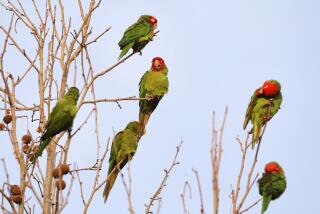Plan to Save Condors Not Changed by Fossil Find
- Share via
The recent discovery of California condor fossils in New York demonstrates that the highly endangered vulture is more adaptable than widely believed, but it will have no immediate impact on efforts to reintroduce the great bird to the wild.
That is the consensus of condor experts contacted Thursday in the wake of the revelation this week that New York researchers had recovered three fossilized bones from one or more California condors that lived 11,000 years ago. Before the latest find, physical evidence indicated that the bird had once inhabited what is now Florida, the southwestern United States and the Pacific Coast of North America.
“This implies to us that the condor is able to tolerate much harsher conditions than we had imagined,” said Lloyd Kiff, director of the Western Foundation of Vertebrate Zoology, a private foundation in Los Angeles. However, many researchers had long believed that the bird was more hardy than its public image and that the presence of man was most likely responsible for the condor’s shrinking range.
“Condors could probably survive in a lot more areas if food was available, and people weren’t shooting them and they weren’t eating lead,” noted Amadeo Rea, curator of birds and mammals at the Natural History Museum in San Diego.
Experts agreed that the find would not alter the ongoing effort to breed condors in captivity and release them into the wild.
“I don’t believe that it (the New York find) has any relevance at this point,” said Joe Dowhan, recovery coordinator for the U.S. Fish and Wildlife Service at the condor research center in Ventura.
The center, along with the Wild Animal Park in San Diego and the Los Angeles Zoo, is involved in an extensive effort to collect wild condors for future breeding and re-introduction into the wild within five years.
Only one known California condor remains in the wild. A total of 26 others live in captivity--13 in San Diego and the 13 in Los Angeles.
The California condor is a graceful bird with wingspans of up to 9.5 feet. A member of the vulture family, it is a carrion eater related to the somewhat larger and more prevalent Andean condor of South America.
For the last half-century, the California condor’s range has been limited to the state of California. However, the bird survived in Baja California until the 1930s, and in the 19th Century it was found to be residing in the Pacific Northwest. Previous fossil findings have also placed the bird in what is now Florida and throughout the southwestern United States.
Contributing to the condor’s decline, researchers say, are the loss of habitat, the spread of pesticides and other poisons, poaching, and the use by hunters of toxic lead shot, which is ingested by condors feeding on dead game.
The finds in western New York state were made between 1984 and 1986 by David Steadman, a paleontologist with the New York State Museum. The fossils included bones from the upper wing, shoulder and foot, all taken from a layer of sediment dating to 11,000 years ago, museum officials said.
More to Read
Sign up for Essential California
The most important California stories and recommendations in your inbox every morning.
You may occasionally receive promotional content from the Los Angeles Times.










